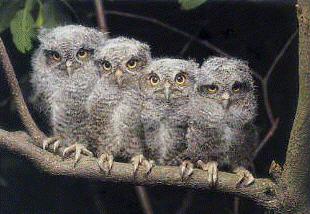
Owls
Cynthia Berger
(Stackpole)

Research by psychologist Norman Li has revealed that besides full lips and soft skin, the one element that makes children and other animals attractive to the rest of humanity is the relative size of their eyes. Thus marsupials (or babies) with squinty eyes are less endearing than, say a Burmese cat or a Cocker Spaniel (or Paris Hilton).By this logic, owls should be the most lovable of them all, but after reading Cynthia Berger's catalogue of their eating and living habits, I think you'd be better off with a lemur or a platypus.
Take your typical strigiformes diet. Gopher stew. Voles on toast. Lemming squash. Nuthatch fricassee. Duckling soup. Moth paste. Cats flambé. And, yuck, the common dung beetle.
According to Ms. Berger, the Burrowing Owl goes about the prairie picking up "cowpies, horse manure, dog dirt, whatever" and "arranges the smelly treasures around the entrances to their burrows." They also line the inner walls of their little cellars with this crap.
Some nosy scientists thought they were dragging this foul mess home to fool their predators, who would leave off digging in and stealing their eggs because it all was so revolting. Not so. The Burrowing Owl has a vast appetite for dung beetles. Dung beetles go to, well, where the shit is. It's a drive-in restaurant for the owls, except instead of going through the golden arches to get a hamburger, the hamburger crawls up to your front door. In case you have a fondness for crunching beetles, this is an ideal arrangement.
Owls also are addicted to eating rats and mice. And they don't just tear them apart: When the Barn Owl catches a mouse, it "just swallows it head-first ... no dainty small bites."
Not only are their table-manners deplorable, their accommodations are vomit-inducing. The Screech Owl will typically have a nest filled up with various types of garbage. "The bottom of an owl's nest makes a nice home," says Ms. Berger, although we believe the word "nice" here should be considered relative. "It's a messy mulch of its own feces, coughed up owl pellets, and the remains of prey such as mice and beetles."
Ants and fly maggots move in to feed on this, so it becomes a stinkpot cafeteria. To make it even more vile, some owls bring home Texas blind snakes --- live ones --- who, once in the nest, defecate and release "a noxious, smelly liquid, then writhe so that the slippery mess coats their small bodies."
No one can figure out why owls bring home these disgusting characters to be their roommates. It reminds us of Ms. Downey, down the street, who lives with thirty-five (or thirty-eight, or forty-three) cats: the atmosphere downwind from her house can peel the bark off our elms.
§ § § Owls has, without much effort, managed to temper our interest in getting to know the Spotted Owl or Ferruginous Pygmy-Owl or the Flammulated Owl. In this volume, there are, in all, eighteen species pictured. Ms. Berger shows herself to be a lively, companionable and occasionally zany expert on these characters.
Owls, by the way, don't just hoot. They also purr, snore, hiss, chirrup, twitter, whinny, and, when they hear a funny joke, chuckle. Didja hear the one about the Screech Owl that went into the bar...
They also go boop-boop-boop. Just like Little Richard.
--- C. S. Trotter